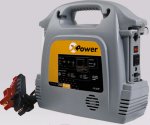Search engine visitors - click here to access entire "$ensible Home" web site
Click here to see a descriptive illustration showing portable power packs and several in use.
Dear Jim: It might sound silly, but with potential terrorism, snipers, etc., I am concerned about losing the electric power. I cannot afford a back-up generator. What type of battery systems are available? - Peg N.

A: Your concerns are not silly at all. People often forget that many home security systems stop functioning when the power goes off and the internal battery runs down. I keep a portable battery back-up power supply charged to operate my security system, a TV, light and laptop computer when the power goes off.
There are portable battery power packs available, like the one I use at home, that allow you to plug standard 110-volt appliances directly into them. Most of these unit also have an outlet for 12-volts to start your car in case your car battery runs down or to power other battery-operated devices.
In addition to emergencies, battery power packs are ideal for camping, fishing, picnicking, and using power tools or lights outdoors. They use sealed lead acid batteries so they are safe to move and handle. It is all housed in a plastic case with a handle and built-in electric outlets.
To use batteries to operate household appliances, the direct current (DC) battery power must be converted to 110-volt alternating current (AC). This requires the DC power to run through an inverter to convert it to AC. Some power packs have a built-in inverter while others use a plug-in one.
The amount of electric energy stored in a battery is measured in amp-hours. Power packs range in output from about seven to 100 amp-hours depending on the size and number of the batteries inside. The weight also varies from about 10 pounds for a small one to more than 80 pounds for a powerful one.
An 18- to 20-amp-hour model is adequate for most household emergencies and outdoor recreational use. They weigh only about 20 pounds. This size power pack can operate a lamp for 12 hours, a security system for two days, a small television for 10 hours, or a sump pump for two hours.
Most power packs have a tiny charger you plug into a wall outlet. They include either a gauge or LED lights to let you know when they are fully charged. They can also be charged from your car while you drive (plug it into the cigarette lighter) or attach it to solar panels or small windmills for free charging.
Depending on how you plan to use the power pack, there are several features to consider. For strictly home use, just the 110-volt outlets are most important. For use in your car too, consider a model with a built-in air pump and a bright built-in spot light to see at night and a snap-on red lens to alert others you need assistance.
Instant Download Update Bulletin No. 400 - buyer's guide of six portable power pack and plug-in inverter manufacturers listing nominal voltage, battery power in amp-hours, battery pack type, features, weights, sizes, many illustrations and prices of various models, chart showing household electrical appliances and typical wattage consumption with estimated run time, chart showing automotive/marine accessories and typical current draw with estimated run time.
Dear Jim: I have been getting quotes on installing a heat pump system. Several of the lower quotes did not include a concrete pad. Is a concrete pad really necessary or can it be installed without one? - Ruth S.
A: The purpose of a concrete pad is to keep the outdoor compressor unit stable and level. Having a pad is particularly important with heat pumps because they can produce dripping water in the defrost mode.
The concrete pad does not have to be elaborate or extremely thick. Building a simple square form with lumber and pouring in the concrete should not dramatically increase the overall cost of the installation job.